
- Login/Register
- Solar System
- Exotic Objects
- Upcoming Events
- Deep-Sky Objects
- Observing Basics
- Telescopes and Equipment
- Astrophotography
- Space Exploration
- Human Spaceflight
- Robotic Spaceflight
- The Magazine

What is the speed of light? Here’s the history, discovery of the cosmic speed limit
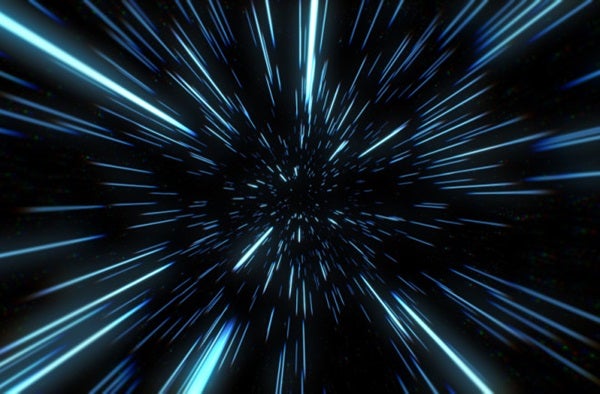
On one hand, the speed of light is just a number: 299,792,458 meters per second. And on the other, it’s one of the most important constants that appears in nature and defines the relationship of causality itself.
As far as we can measure, it is a constant. It is the same speed for every observer in the entire universe. This constancy was first established in the late 1800’s with the experiments of Albert Michelson and Edward Morley at Case Western Reserve University . They attempted to measure changes in the speed of light as the Earth orbited around the Sun. They found no such variation, and no experiment ever since then has either.
Observations of the cosmic microwave background, the light released when the universe was 380,000 years old, show that the speed of light hasn’t measurably changed in over 13.8 billion years.
In fact, we now define the speed of light to be a constant, with a precise speed of 299,792,458 meters per second. While it remains a remote possibility in deeply theoretical physics that light may not be a constant, for all known purposes it is a constant, so it’s better to just define it and move on with life.
How was the speed of light first measured?
In 1676 the Danish astronomer Ole Christensen Romer made the first quantitative measurement of how fast light travels. He carefully observed the orbit of Io, the innermost moon of Jupiter. As the Earth circles the Sun in its own orbit, sometimes it approaches Jupiter and sometimes it recedes away from it. When the Earth is approaching Jupiter, the path that light has to travel from Io is shorter than when the Earth is receding away from Jupiter. By carefully measuring the changes to Io’s orbital period, Romer calculated a speed of light of around 220,000 kilometers per second.
Observations continued to improve until by the 19 th century astronomers and physicists had developed the sophistication to get very close to the modern value. In 1865, James Clerk Maxwell made a remarkable discovery. He was investigating the properties of electricity and magnetism, which for decades had remained mysterious in unconnected laboratory experiments around the world. Maxwell found that electricity and magnetism were really two sides of the same coin, both manifestations of a single electromagnetic force.
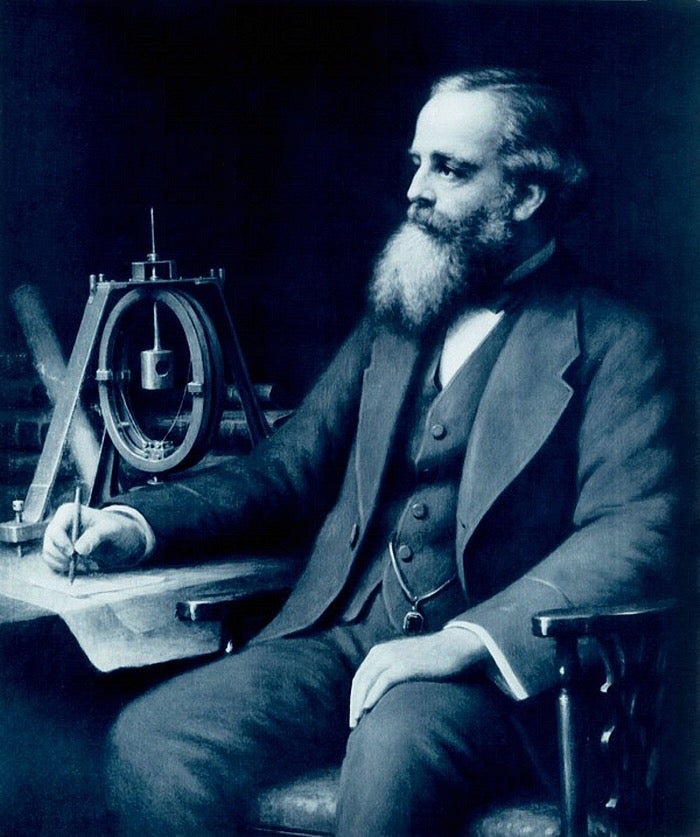
As Maxwell explored the consequences of his new theory, he found that changing magnetic fields can lead to changing electric fields, which then lead to a new round of changing magnetic fields. The fields leapfrog over each other and can even travel through empty space. When Maxwell went to calculate the speed of these electromagnetic waves, he was surprised to see the speed of light pop out – the first theoretical calculation of this important number.
What is the most precise measurement of the speed of light?
Because it is defined to be a constant, there’s no need to measure it further. The number we’ve defined is it, with no uncertainty, no error bars. It’s done. But the speed of light is just that – a speed. The number we choose to represent it depends on the units we use: kilometers versus miles, seconds versus hours, and so on. In fact, physicists commonly just set the speed of light to be 1 to make their calculations easier. So instead of trying to measure the speed light travels, physicists turn to more precisely measuring other units, like the length of the meter or the duration of the second. In other words, the defined value of the speed of light is used to establish the length of other units like the meter.
How does light slow down?
Yes, the speed of light is always a constant. But it slows down whenever it travels through a medium like air or water. How does this work? There are a few different ways to present an answer to this question, depending on whether you prefer a particle-like picture or a wave-like picture.
In a particle-like picture, light is made of tiny little bullets called photons. All those photons always travel at the speed of light, but as light passes through a medium those photons get all tangled up, bouncing around among all the molecules of the medium. This slows down the overall propagation of light, because it takes more time for the group of photons to make it through.
In a wave-like picture, light is made of electromagnetic waves. When these waves pass through a medium, they get all the charged particles in motion, which in turn generate new electromagnetic waves of their own. These interfere with the original light, forcing it to slow down as it passes through.
Either way, light always travels at the same speed, but matter can interfere with its travel, making it slow down.
Why is the speed of light important?
The speed of light is important because it’s about way more than, well, the speed of light. In the early 1900’s Einstein realized just how special this speed is. The old physics, dominated by the work of Isaac Newton, said that the universe had a fixed reference frame from which we could measure all motion. This is why Michelson and Morley went looking for changes in the speed, because it should change depending on our point of view. But their experiments showed that the speed was always constant, so what gives?
Einstein decided to take this experiment at face value. He assumed that the speed of light is a true, fundamental constant. No matter where you are, no matter how fast you’re moving, you’ll always see the same speed.
This is wild to think about. If you’re traveling at 99% the speed of light and turn on a flashlight, the beam will race ahead of you at…exactly the speed of light, no more, no less. If you’re coming from the opposite direction, you’ll still also measure the exact same speed.
This constancy forms the basis of Einstein’s special theory of relativity, which tells us that while all motion is relative – different observers won’t always agree on the length of measurements or the duration of events – some things are truly universal, like the speed of light.
Can you go faster than light speed?
Nope. Nothing can. Any particle with zero mass must travel at light speed. But anything with mass (which is most of the universe) cannot. The problem is relativity. The faster you go, the more energy you have. But we know from Einstein’s relativity that energy and mass are the same thing. So the more energy you have, the more mass you have, which makes it harder for you to go even faster. You can get as close as you want to the speed of light, but to actually crack that barrier takes an infinite amount of energy. So don’t even try.
How is the speed at which light travels related to causality?
If you think you can find a cheat to get around the limitations of light speed, then I need to tell you about its role in special relativity. You see, it’s not just about light. It just so happens that light travels at this special speed, and it was the first thing we discovered to travel at this speed. So it could have had another name. Indeed, a better name for this speed might be “the speed of time.”
Related: Is time travel possible? An astrophysicist explains
We live in a universe of causes and effects. All effects are preceded by a cause, and all causes lead to effects. The speed of light limits how quickly causes can lead to effects. Because it’s a maximum speed limit for any motion or interaction, in a given amount of time there’s a limit to what I can influence. If I want to tap you on the shoulder and you’re right next to me, I can do it right away. But if you’re on the other side of the planet, I have to travel there first. The motion of me traveling to you is limited by the speed of light, so that sets how quickly I can tap you on the shoulder – the speed light travels dictates how quickly a single cause can create an effect.
The ability to go faster than light would allow effects to happen before their causes. In essence, time travel into the past would be possible with faster-than-light travel. Since we view time as the unbroken chain of causes and effects going from the past to the future, breaking the speed of light would break causality, which would seriously undermine our sense of the forward motion of time.
Why does light travel at this speed?
No clue. It appears to us as a fundamental constant of nature. We have no theory of physics that explains its existence or why it has the value that it does. We hope that a future understanding of nature will provide this explanation, but right now all investigations are purely theoretical. For now, we just have to take it as a given.

In a first, JWST captures ultra-detailed image of aligned jets in the Serpens Nebula
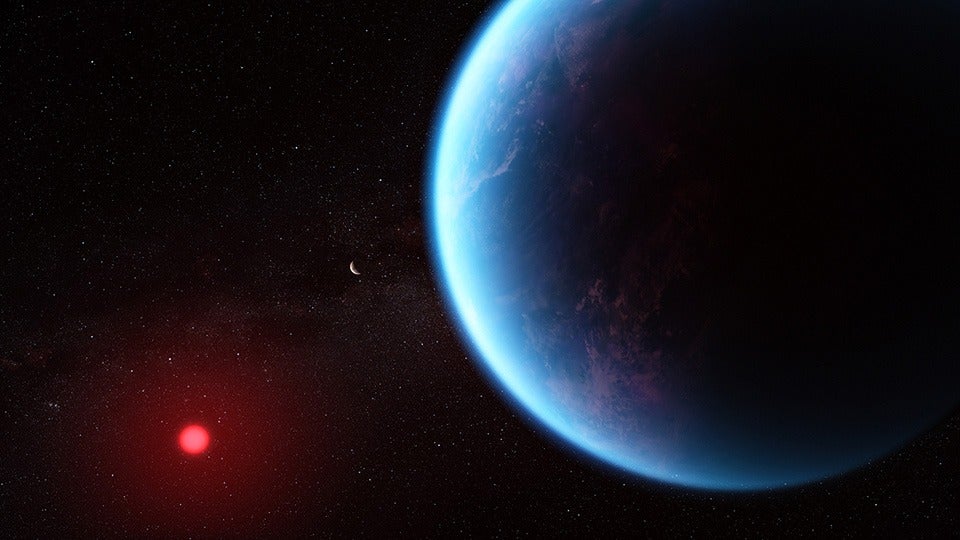
Did we find signs of life on K2-18 b? Not yet, but we might.
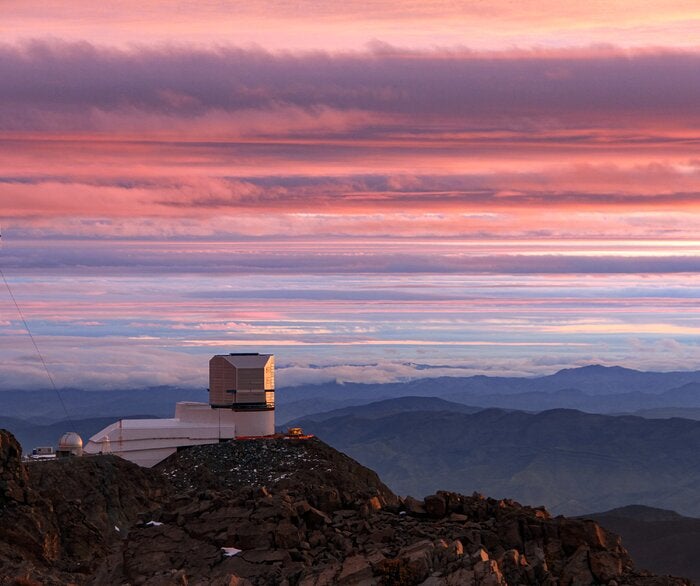
‘It’s going to be awesome’: How the Vera C. Rubin Observatory will survey space and time

2024 Full Moon calendar: When to see the Full Moon and phases
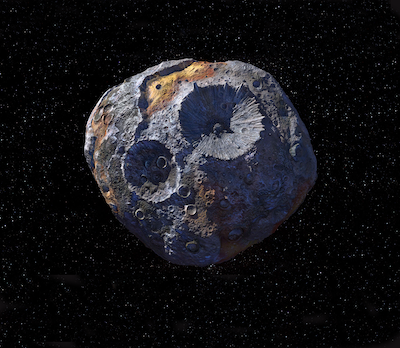
Could Psyche be the core of the planetesimal that struck Earth and formed the Moon?

Unusual glimpse of Cosmic Gems could be a breakthrough for astronomers
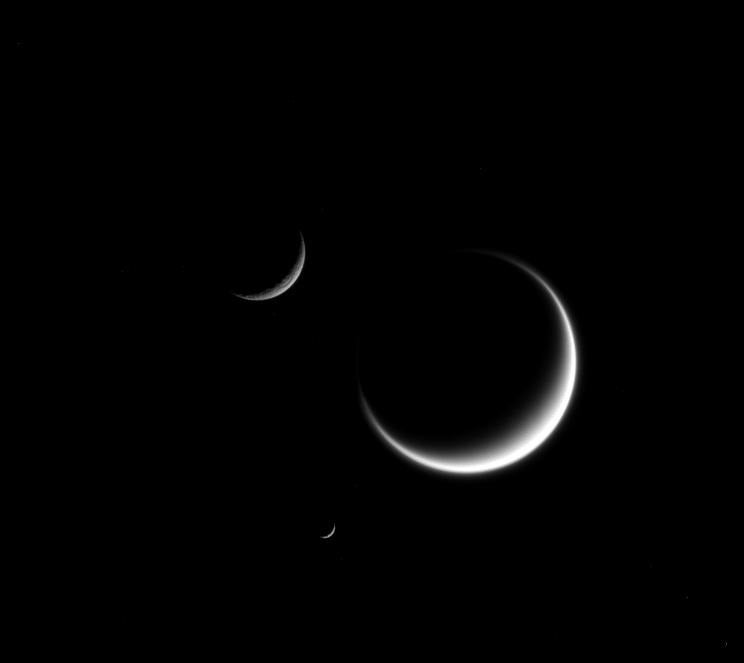
Why does Earth have only one Moon?
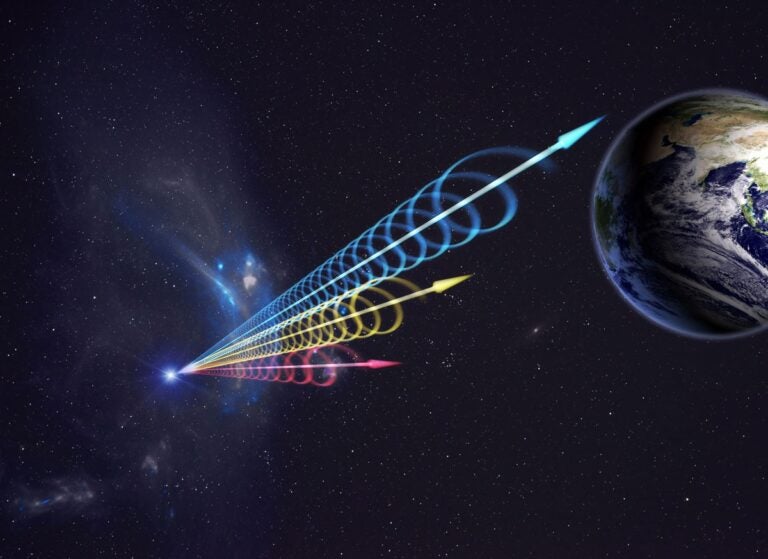
One-shot fast radio bursts may emerge from Milky Way-like galaxies, new research suggests
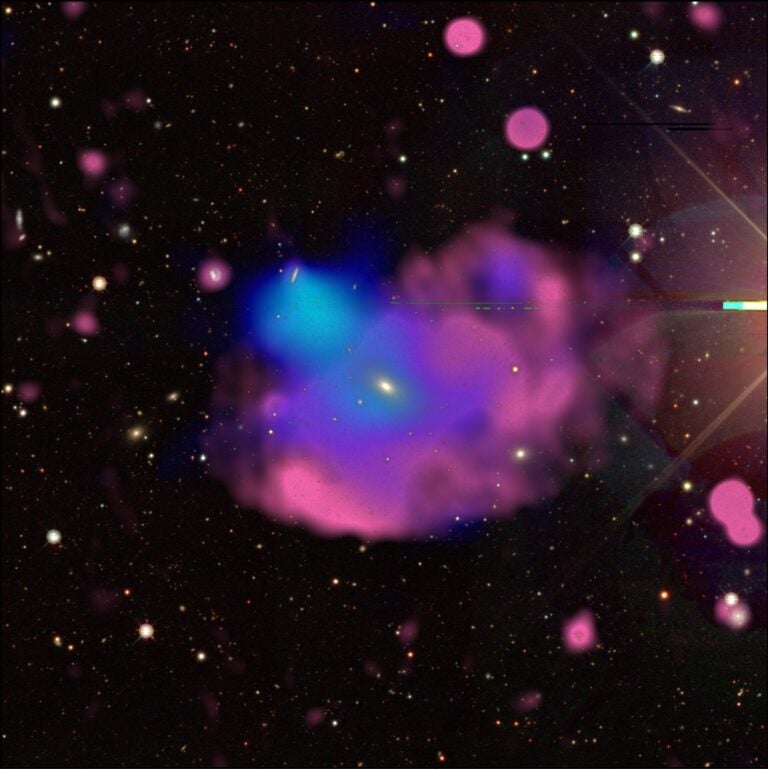
Mysterious Cloverleaf ‘odd radio circle’ could be a merger of a dozen galaxies

Why is the speed of light the way it is?
It's just plain weird.

Paul M. Sutter is an astrophysicist at SUNY Stony Brook and the Flatiron Institute, host of Ask a Spaceman and Space Radio , and author of " How to Die in Space ." He contributed this article to Space.com's Expert Voices: Op-Ed & Insights .
We all know and love the speed of light — 299,792,458 meters per second — but why does it have the value that it does? Why isn't it some other number? And why do we care so much about some random speed of electromagnetic waves? Why did it become such a cornerstone of physics?
Well, it's because the speed of light is just plain weird.
Related: Constant speed of light: Einstein's special relativity survives a high-energy test
Putting light to the test
The first person to realize that light does indeed have a speed at all was an astronomer by the name of Ole Romer. In the late 1600s, he was obsessed with some strange motions of the moon Io around Jupiter. Every once in a while, the great planet would block our view of its little moon, causing an eclipse, but the timing between eclipses seemed to change over the course of the year. Either something funky was happening with the orbit of Io — which seemed suspicious — or something else was afoot.
After a couple years of observations, Romer made the connection. When we see Io get eclipsed, we're in a certain position in our own orbit around the sun. But by the next time we see another eclipse, a few days later, we're in a slightly different position, maybe closer or farther away from Jupiter than the last time. If we are farther away than the last time we saw an eclipse, then that means we have to wait a little bit of extra time to see the next one because it takes that much longer for the light to reach us, and the reverse is true if we happen to be a little bit closer to Jupiter.
The only way to explain the variations in the timing of eclipses of Io is if light has a finite speed.
Get the Space.com Newsletter
Breaking space news, the latest updates on rocket launches, skywatching events and more!
Making it mean something
Continued measurements over the course of the next few centuries solidified the measurement of the speed of light, but it wasn't until the mid-1800s when things really started to come together. That's when the physicist James Clerk Maxwell accidentally invented light.
Maxwell had been playing around with the then-poorly-understood phenomena of electricity and magnetism when he discovered a single unified picture that could explain all the disparate observations. Laying the groundwork for what we now understand to be the electromagnetic force , in those equations he discovered that changing electric fields can create magnetic fields, and vice versa. This allows waves of electricity to create waves of magnetism, which go on to make waves of electricity and back and forth and back and forth, leapfrogging over each other, capable of traveling through space.
And when he went to calculate the speed of these so-called electromagnetic waves, Maxwell got the same number that scientists had been measuring as the speed of light for centuries. Ergo, light is made of electromagnetic waves and it travels at that speed, because that is exactly how quickly waves of electricity and magnetism travel through space.
And this was all well and good until Einstein came along a few decades later and realized that the speed of light had nothing to do with light at all. With his special theory of relativity , Einstein realized the true connection between time and space, a unified fabric known as space-time. But as we all know, space is very different than time. A meter or a foot is very different than a second or a year. They appear to be two completely different things.
So how could they possibly be on the same footing?
There needed to be some sort of glue, some connection that allowed us to translate between movement in space and movement in time. In other words, we need to know how much one meter of space, for example, is worth in time. What's the exchange rate? Einstein found that there was a single constant, a certain speed, that could tell us how much space was equivalent to how much time, and vice versa.
Einstein's theories didn't say what that number was, but then he applied special relativity to the old equations of Maxwell and found that this conversion rate is exactly the speed of light.
Of course, this conversion rate, this fundamental constant that unifies space and time, doesn't know what an electromagnetic wave is, and it doesn't even really care. It's just some number, but it turns out that Maxwell had already calculated this number and discovered it without even knowing it. That's because all massless particles are able to travel at this speed, and since light is massless, it can travel at that speed. And so, the speed of light became an important cornerstone of modern physics.
But still, why that number, with that value, and not some other random number? Why did nature pick that one and no other? What's going on?
Related: The genius of Albert Einstein: his life, theories and impact on science
Making it meaningless
Well, the number doesn't really matter. It has units after all: meters per second. And in physics any number that has units attached to it can have any old value it wants, because it means you have to define what the units are. For example, in order to express the speed of light in meters per second, first you need to decide what the heck a meter is and what the heck a second is. And so the definition of the speed of light is tied up with the definitions of length and time.
In physics, we're more concerned with constants that have no units or dimensions — in other words, constants that appear in our physical theories that are just plain numbers. These appear much more fundamental, because they don't depend on any other definition. Another way of saying it is that, if we were to meet some alien civilization , we would have no way of understanding their measurement of the speed of light, but when it comes to dimensionless constants, we can all agree. They're just numbers.
One such number is known as the fine structure constant, which is a combination of the speed of light, Planck's constant , and something known as the permittivity of free space. Its value is approximately 0.007. 0.007 what? Just 0.007. Like I said, it's just a number.
So on one hand, the speed of light can be whatever it wants to be, because it has units and we need to define the units. But on the other hand, the speed of light can't be anything other than exactly what it is, because if you were to change the speed of light, you would change the fine structure constant. But our universe has chosen the fine structure constant to be approximately 0.007, and nothing else. That is simply the universe we live in, and we get no choice about it at all. And since this is fixed and universal, the speed of light has to be exactly what it is.
So why is the fine structure constant exactly the number that it is, and not something else? Good question. We don't know.
Learn more by listening to the episode "Why is the speed of light the way it is?" on the Ask A Spaceman podcast, available on iTunes and on the Web at http://www.askaspaceman.com. Thanks to Robert H, Michael E., @DesRon94, Evan W., Harry A., @twdixon, Hein P., Colin E., and Lothian53 for the questions that led to this piece! Ask your own question on Twitter using #AskASpaceman or by following Paul @PaulMattSutter and facebook.com/PaulMattSutter.
Join our Space Forums to keep talking space on the latest missions, night sky and more! And if you have a news tip, correction or comment, let us know at: [email protected].
Paul M. Sutter is an astrophysicist at SUNY Stony Brook and the Flatiron Institute in New York City. Paul received his PhD in Physics from the University of Illinois at Urbana-Champaign in 2011, and spent three years at the Paris Institute of Astrophysics, followed by a research fellowship in Trieste, Italy, His research focuses on many diverse topics, from the emptiest regions of the universe to the earliest moments of the Big Bang to the hunt for the first stars. As an "Agent to the Stars," Paul has passionately engaged the public in science outreach for several years. He is the host of the popular "Ask a Spaceman!" podcast, author of "Your Place in the Universe" and "How to Die in Space" and he frequently appears on TV — including on The Weather Channel, for which he serves as Official Space Specialist.
Is there liquid water on Mars today? Marsquake data could tell us
Ed Stone, who led NASA's iconic Voyager project for 50 years, dies at 88
Planet Nine: Is the search for this elusive world nearly over?
- voidpotentialenergy This is just my opinion but i think L speed is it's speed because the particle part of it is the fastest it can interact with the quanta distance in quantum fluctuation. Light is particle and wave so the wave happens in the void between quanta. Gravity probably travels in that void and why gravity seems instant. Reply
- rod The space.com article wraps up the discussion with, "So on one hand, the speed of light can be whatever it wants to be, because it has units and we need to define the units. But on the other hand, the speed of light can't be anything other than exactly what it is, because if you were to change the speed of light, you would change the fine structure constant. But our universe has chosen the fine structure constant to be approximately 0.007, and nothing else. That is simply the universe we live in, and we get no choice about it at all. And since this is fixed and universal, the speed of light has to be exactly what it is. So why is the fine structure constant exactly the number that it is, and not something else? Good question. We don't know." It seems that the *universe* made this decision, *But our universe has chosen the fine structure constant to be...* I did not know that the universe was capable of making decisions concerning constants used in physics. E=mc^2 is a serious constant. Look at nuclear weapons development, explosive yields, and stellar evolution burn rates for p-p chain and CNO fusion rates. The report indicates why alpha (fine structure constant) is what it is and c is what it is, *We don't know*. Reply
Admin said: We all know and love the speed of light, but why does it have the value that it does? Why isn't it some other number? And why did it become such a cornerstone of physics? Why is the speed of light the way it is? : Read more
rod said: The space.com article wraps up the discussion with, "So on one hand, the speed of light can be whatever it wants to be, because it has units and we need to define the units. But on the other hand, the speed of light can't be anything other than exactly what it is, because if you were to change the speed of light, you would change the fine structure constant. But our universe has chosen the fine structure constant to be approximately 0.007, and nothing else. That is simply the universe we live in, and we get no choice about it at all. And since this is fixed and universal, the speed of light has to be exactly what it is. So why is the fine structure constant exactly the number that it is, and not something else? Good question. We don't know." It seems that the *universe* made this decision, *But our universe has chosen the fine structure constant to be...* I did not know that the universe was capable of making decisions concerning constants used in physics. E=mc^2 is a serious constant. Look at nuclear weapons development, explosive yields, and stellar evolution burn rates for p-p chain and CNO fusion rates. The report indicates why alpha (fine structure constant) is what it is and c is what it is, *We don't know*.
- rod FYI. When someone says *the universe has chosen*, I am reminded of these five lessons from a 1982 Fed. court trial. The essential characteristics of science are: It is guided by natural law; It has to be explanatory by reference to natural law; It is testable against the empirical world; Its conclusions are tentative, i.e., are not necessarily the final word; and It is falsifiable. Five important points about science. Reply
- Gary If the universe is expanding , how can the speed of light be constant ( miles per second , if each mile is getting longer ) ? Can light's velocity be constant while the universe expands ? So, with the expansion of the universe , doesn't the speed of light need to increase in order to stay at a constant velocity in miles per second ? Or, do the miles in the universe remain the same length as the universe 'adds' miles to its diameter ? Are the miles lengthening or are they simply being added / compounded ? Reply
- Gary Lets say we're in outer space and we shoot a laser through a block of glass. What causes the speed of the laser light to return to the speed it held prior to entering the block of glass ? Is there some medium in the vacuum of space that governs the speed of light ? Do the atoms in the glass push it back up to its original speed. If so, why don't those same atoms constantly push the light while it travels through the block of glass ? Reply
Gary said: Lets say we're in outer space and we shoot a laser through a block of glass. What causes the speed of the laser light to return to the speed it held prior to entering the block of glass ? Is there some medium in the vacuum of space that governs the speed of light ? Do the atoms in the glass push it back up to its original speed. If so, why don't those same atoms constantly push the light while it travels through the block of glass ?
Gary said: If the universe is expanding , how can the speed of light be constant ( miles per second , if each mile is getting longer ) ? Can light's velocity be constant while the universe expands ? So, with the expansion of the universe , doesn't the speed of light need to increase in order to stay at a constant velocity in miles per second ? Or, do the miles in the universe remain the same length as the universe 'adds' miles to its diameter ? Are the miles lengthening or are they simply being added / compounded ?
- View All 31 Comments
Most Popular
- 2 New 'Star Wars Outlaws' gameplay trailer dives into the galactic underworld (video)
- 3 'Star Trek: Prodigy' warps into Season 2 with new Netflix trailer (video)
- 4 How the GOES U satellite will change Earth and space weather forecasts forever
- 5 Perseverance Mars rover digs into intriguing 'Bright Angel' rock formation (photo)
NOTIFICATIONS
Light basics.
- + Create new collection
Light is a form of energy produced by a light source. Light is made of photons that travel very fast. Photons of light behave like both waves and particles.
Light sources
Something that produces light is called a light source. There are two main kinds of light sources:

Fireworks show how light travels faster than sound. We see the light almost instantly, but the sound arrives later. To work out how many kilometres away the fireworks are, count the seconds until you hear the bang and divide by 3.
Incandescent sources use heat to produce light. Nearly all solids, liquids and gases will start to glow with a dull red colour once they reach a temperature of about 525 °C. At about 2300 °C, the filament in a light bulb will start to produce all of the colours of the visible spectrum, so it will look white. The Sun, stars, a flame and molten metal are all incandescent.
Luminescent sources are normally cooler and can be produced by chemical reactions, such as in a glowstick or a glow-worm. Other luminescent sources include a computer screen, fluorescent lights and LEDs.
Light travels much faster than sound
Light travels at a speed of 299,792,458 m/s (that’s nearly 300,000 km/s!). The distance around the Earth is 40,000 km, so in 1 second, light could travel seven and a half times around the world.
Sound only travels at about 330 m/s through the air, so light is nearly a million times faster than sound.
If lightning flashes 1 kilometre away from you, the light reaches you in 3 millionths of a second, which is almost instantly. The sound of the thunder takes 3 seconds to travel 1 kilometre – to work out many kilometres away lightning is, count the seconds for the thunder to arrive and divide by 3.
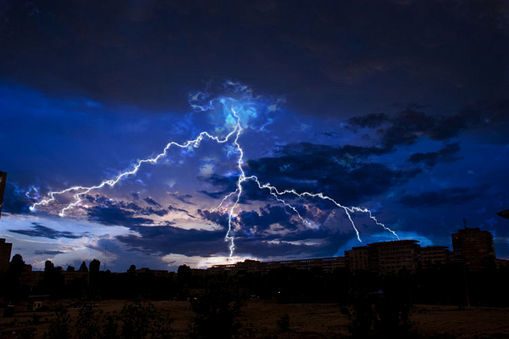
Lightning storms are important for converting nitrogen gas in the atmosphere through to forms that are biologically available.
Light takes about 8 minutes and 20 seconds to reach the Earth from the Sun. When we see the Sun, we are seeing what it looked like over 8 minutes ago.
Light can travel through empty space
Unlike sound, which needs a medium (like air or water) to travel through, light can travel in the vacuum of space.
Light travels in straight lines
Once light has been produced, it will keep travelling in a straight line until it hits something else.
Shadows are evidence of light travelling in straight lines. An object blocks light so that it can’t reach the surface where we see the shadow. Light fills up all of the space before it hits the object, but the whole region between the object and the surface is in shadow. Shadows don’t appear totally dark because there is still some light reaching the surface that has been reflected off other objects.
Once light has hit another surface or particles, it is then absorbed, reflected (bounces off), scattered (bounces off in all directions), refracted (direction and speed changes) or transmitted (passes straight through).
Models for light
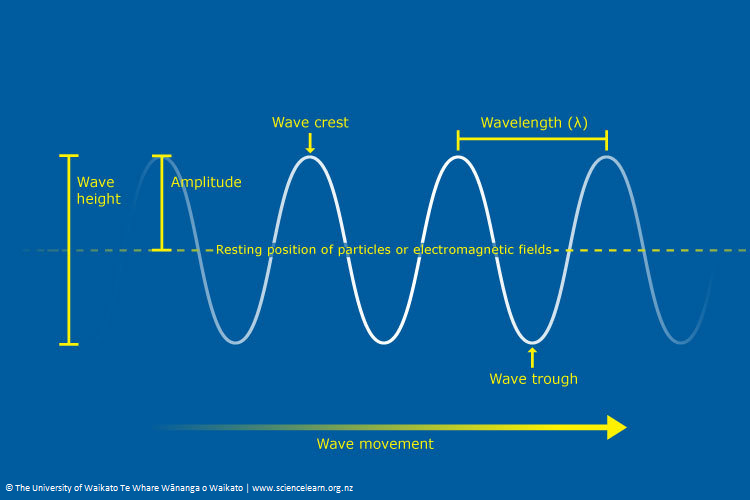
Wave length, height and frequency
A wave can be described by its length, height (amplitude) and frequency.
Light as waves
Rainbows and prisms can split white light up into different colours. Experiments can be used to show that each of these colours has a different wavelength.
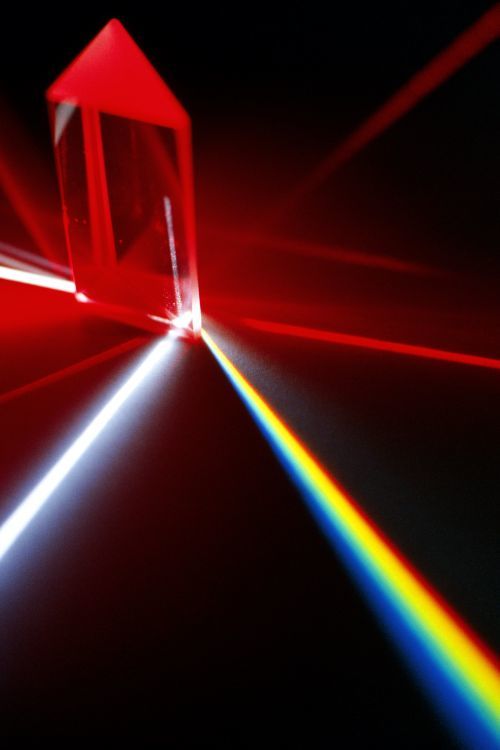
When white light shines through a prism, each colour refracts at a slightly different angle. Violet light refracts slightly more than red light. A prism can be used to show the seven colours of the spectrum that make up white light.
At the beach, the wavelength of water waves might be measured in metres, but the wavelength of light is measured in nanometres – 10 -9 (0.000,000,001) of a metre. Red light has a wavelength of nearly 700 nm (that’s 7 ten-thousandths of a millimetre) while violet light is only 400 nm (4 ten-thousandths of a millimetre).
Visible light is only a very small part of the electromagnetic spectrum – it’s just that this is the range of wavelengths our eyes can detect.
Light as particles
In 1905, Albert Einstein proposed that light is made of billions of small packets of energy that we now call photons. These photons have no mass, but each photon has a specific amount of energy that depends on its frequency (number of vibrations per second). Each photon still has a wavelength. Shorter wavelength photons have more energy.
The photoelectric effect
University of Waikato science researcher Dr Adrian Dorrington explains the photoelectric effect. He then describes how camera sensors can be designed on the basis of this effect to enable light energy to be converted into electric potential energy.
The photoelectric effect is when light can cause electrons to jump out of a metal. These experiments confirm that light is made of these massless particles called photons.
Simple explanations of some of these concepts can be found in the article Building Science Concepts: Shadows .
Nature of science
In order to understand the world we live in, scientists often use models. Sometimes, several models are needed to explain the properties and behaviours of a phenomenon. For example, to understand the behaviour of light, two models are needed. Light needs to be thought of as both waves and particles.
Useful links
Even though light doesn’t have mass, learn how it still has a tiny amount of momentum. Find out about NASA’s solar sails to power spacecraft.
Read about the LightSail project, a crowdfunded project from The Planetary Society, aiming to demonstrate that solar sailing is a viable means of propulsion for CubeSats (miniature satellites intended for low Earth orbit).
Explore solar sails more in your classroom, with this activity Solar Sails: The Future of Space Travel from the TeachEngineering website.
See our newsletters here .
Would you like to take a short survey?
This survey will open in a new tab and you can fill it out after your visit to the site.
The Nature of Light
Introduction.
Light is a transverse, electromagnetic wave that can be seen by the typical human. The wave nature of light was first illustrated through experiments on diffraction and interference . Like all electromagnetic waves, light can travel through a vacuum. The transverse nature of light can be demonstrated through polarization .
- In 1678, Christiaan Huygens (1629–1695) published Traité de la Lumiere , where he argued in favor of the wave nature of light. Huygens stated that an expanding sphere of light behaves as if each point on the wave front were a new source of radiation of the same frequency and phase.
- Thomas Young (1773–1829) and Augustin-Jean Fresnel (1788–1827) disproved Newton's corpuscular theory.
Light is produced by one of two methods…
- Incandescence is the emission of light from "hot" matter (T ≳ 800 K).
- Luminescence is the emission of light when excited electrons fall to lower energy levels (in matter that may or may not be "hot").
Just notes so far. The speed of light in a vacuum is represented by the letter c from the Latin celeritas — swiftness. Measurements of the speed of light.
Veramente non l'ho sperimentata, salvo che in lontananza piccola, cioè manco d'un miglio, dal che non ho potuto assicurarmi se veramente la comparsa del lume opposto sia instantanea; ma ben, se non instantanea, velocissima…. In fact I have tried the experiment only at a short distance, less than a mile, from which I have not been able to ascertain with certainty whether the appearance of the opposite light was instantaneous or not; but if not instantaneous it is extraordinarily rapid …. Galileo Galilei, 1638 Galileo Galilei, 1638
Ole Rømer (1644–1710) Denmark. "Démonstration touchant le mouvement de la lumière trouvé par M. Roemer de l'Académie des Sciences." Journal des Scavans . 7 December 1676. Rømer's idea was to use the transits of Jupiter's moon Io to determine the time. Not local time, which was already possible, but a "universal" time that would be the same for all observers on the Earth, Knowing the standard time would allow one to determine one's longitude on the Earth — a handy thing to know when navigating the featureless oceans.
Unfortunately, Io did not turn out to be a good clock. Rømer observed that times between eclipses got shorter as Earth approached Jupiter, and longer as Earth moved farther away. He hypothesized that this variation was due to the time it took for light to travel the lesser or greater distance, and estimated that the time for light to travel the diameter of the Earth's orbit, a distance of two astronomical units, was 22 minutes.
- The speed of light in a vacuum is a universal constant in all reference frames.
- The speed of light in a vacuum is fixed at 299,792,458 m/s by the current definition of the meter.
- The speed of light in a medium is always slower the speed of light in a vacuum.
- The speed of light depends upon the medium through which it travels.The speed of anything with mass is always less than the speed of light in a vacuum.
other characteristics
The amplitude of a light wave is related to its intensity.
- Intensity is the absolute measure of a light wave's power density.
- Brightness is the relative intensity as perceived by the average human eye.
The frequency of a light wave is related to its color.
- Color is such a complex topic that it has its own section in this book.
- Laser light is effectively monochromatic.
- There are six simple, named colors in English (and many other languages) each associated with a band of monochromatic light. In order of increasing frequency they are red, orange, yellow, green, blue, and violet .
- Light is sometimes also known as visible light to contrast it from "ultraviolet light" and "infrared light"
- Other forms of electromagnetic radiation that are not visible to humans are sometimes also known informally as "light"
- Nearly every light source is polychromatic.
- White light is polychromatic.
A graph of relative intensity vs. frequency is called a spectrum (plural: spectra ). Although frequently associated with light, the term can be applied to any wave phenomena.
- Blackbody radiators emit a continuous spectrum.
- The excited electrons in a gas emit a discrete spectrum.
The wavelength of a light wave is inversely proportional to its frequency.
- Light is often described by it's wavelength in a vacuum .
- Light ranges in wavelength from 400 nm on the violet end to 700 nm on the red end of the visible spectrum.
Phase differences between light waves can produce visible interference effects. (There are several sections in this book on interference phenomena and light.)
Leftovers about animals.
- Falcon can see a 10 cm. object from a distance of 1.5 km.
- Fly's Eye has a flicker fusion rate of 300/s. Humans have a flicker fusion rate of only 60/s in bright light and 24/s in dim light. The flicker fusion rate is the frequency with which the "flicker" of an image cannot be distinguished as an individual event. Like the frame of a movie… if you slowed it down, you would see individual frames. Speed it up and you see a constantly moving image. Octopus' eye has a flicker fusion frequency of 70/s in bright light.
- Penguin has a flat cornea that allows for clear vision underwater. Penguins can also see into the ultraviolet range of the electromagnetic spectrum.
- Sparrow Retina has 400,000 photoreceptors per square. mm.
- Reindeer can see ultraviolet wavelengths, which may help them view contrasts in their mostly white environment.
What is the speed of light?
Light is faster than anything else in the known universe, though its speed can change depending on what it's passing through.

The universe has a speed limit, and it's the speed of light. Nothing can travel faster than light — not even our best spacecraft — according to the laws of physics.
So, what is the speed of light?
Light moves at an incredible 186,000 miles per second (300,000 kilometers per second), equivalent to almost 700 million mph (more than 1 billion km/h). That's fast enough to circumnavigate the globe 7.5 times in one second, while a typical passenger jet would take more than two days to go around once (and that doesn't include stops for fuel or layovers!).
Light moves so fast that, for much of human history, we thought it traveled instantaneously. As early as the late 1600s, though, scientist Ole Roemer was able to measure the speed of light (usually referred to as c ) by using observations of Jupiter's moons, according to Britannica .
Around the turn of the 19th century, physicist James Clerk Maxwell created his theories of electromagnetism . Light is itself made up of electric and magnetic fields, so electromagnetism could describe the behavior and motion of light — including its theoretical speed. That value was 299,788 kilometers per second, with a margin of error of plus or minus 30. In the 1970s, physicists used lasers to measure the speed of light with much greater precision, leaving an error of only 0.001. Nowadays, the speed of light is used to define units of length, so its value is fixed; humans have essentially agreed the speed of light is 299,792.458 kilometers per second, exactly.
Light doesn't always have to go so fast, though. Depending on what it's traveling through — air, water, diamonds, etc. — it can slow down. The official speed of light is measured as if it's traveling in a vacuum, a space with no air or anything to get in the way. You can most clearly see differences in the speed of light in something like a prism, where certain energies of light bend more than others, creating a rainbow.
— How many moons does Earth have ?
— What would happen if the moon were twice as close to Earth?
— If you're on the moon, does the Earth appear to go through phases?
Interestingly, the speed of light is no match for the vast distances of space, which is itself a vacuum. It takes 8 minutes for light from the sun to reach Earth, and a couple years for light from the other closest stars (like Proxima Centauri) to get to our planet. This is why astronomers use the unit light-years — the distance light can travel in one year — to measure vast distances in space.
Sign up for the Live Science daily newsletter now
Get the world’s most fascinating discoveries delivered straight to your inbox.
Because of this universal speed limit, telescopes are essentially time machines . When astronomers look at a star 500 light-years away, they're looking at light from 500 years ago. Light from around 13 billion light-years away (equivalently, 13 billion years ago) shows up as the cosmic microwave background, remnant radiation from the Big Bang in the universe's infancy. The speed of light isn't just a quirk of physics; it has enabled modern astronomy as we know it, and it shapes the way we see the world — literally.
Briley Lewis (she/her) is a freelance science writer and Ph.D. Candidate/NSF Fellow at the University of California, Los Angeles studying Astronomy & Astrophysics. Follow her on Twitter @briles_34 or visit her website www.briley-lewis.com .
'The early universe is nothing like we expected': James Webb telescope reveals 'new understanding' of how galaxies formed at cosmic dawn
James Webb telescope reveals 'cataclysmic' asteroid collision in nearby star system
'Holy grail' of solar technology set to consign 'unsustainable silicon' to history
Most Popular
- 2 32 of the most dangerous animals on Earth
- 3 'The early universe is nothing like we expected': James Webb telescope reveals 'new understanding' of how galaxies formed at cosmic dawn
- 4 2,000-year-old Roman military sandal with nails for traction found in Germany
- 5 Have giant humans ever existed?
- 2 2,000-year-old Roman military sandal with nails for traction found in Germany
- 3 Human ancestor 'Lucy' was hairless, new research suggests. Here's why that matters.
- 4 James Webb telescope spots a dozen newborn stars spewing gas in the same direction — and nobody is sure why
- 5 Astronauts stranded in space due to multiple issues with Boeing's Starliner — and the window for a return flight is closing
Advertisement
How Light Works
- Share Content on Facebook
- Share Content on LinkedIn
- Share Content on Flipboard
- Share Content on Reddit
- Share Content via Email

Light is at once both obvious and mysterious. We are bathed in yellow warmth every day and stave off the darkness with incandescent and fluorescent bulbs . But what exactly is light? We catch glimpses of its nature when a sunbeam angles through a dust-filled room, when a rainbow appears after a storm or when a drinking straw in a glass of water looks disjointed. These glimpses, however, only lead to more questions. Does light travel as a wave, a ray or a stream of particles? Is it a single color or many colors mixed together? Does it have a frequency like sound? And what are some of the common properties of light, such as absorption, reflection, refraction and diffraction?
You might think scientists know all the answers, but light continues to surprise them. Here's an example: We've always taken for granted that light travels faster than anything else in the universe. Then, in 1999, researchers at Harvard University were able to slow a beam of light down to 38 miles an hour (61 kilometers per hour) by passing it through a state of matter known as a Bose-Einstein condensate. That's almost 18 million times slower than normal! No one would have thought such a feat possible just a few years ago, yet this is the capricious way of light. Just when you think you have it figured out, it defies your efforts and seems to change its nature.
Still, we've come a long way in our understanding. Some of the brightest minds in the history of science have focused their powerful intellects on the subject. Albert Einstein tried to imagine what it would be like to ride on a beam of light. "What if one were to run after a ray of light?" he asked. "What if one were riding on the beam? … If one were to run fast enough, would it no longer move at all?"
Einstein, though, is getting ahead of the story. To appreciate how light works, we have to put it in its proper historical context. Our first stop is the ancient world, where some of the earliest scientists and philosophers pondered the true nature of this mysterious substance that stimulates sight and makes things visible.
Please copy/paste the following text to properly cite this HowStuffWorks.com article:
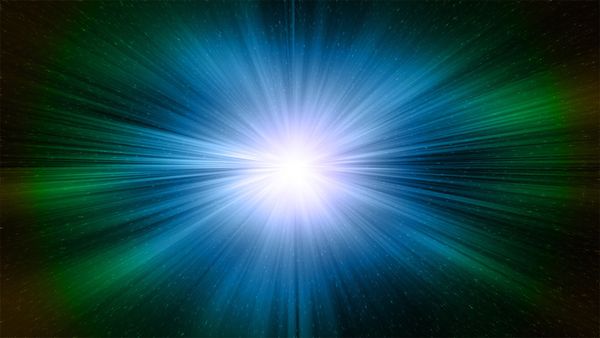
It’s a wonderful world — and universe — out there.
Come explore with us!
Science News Explores
Understanding light and other forms of energy on the move.
This radiation includes visible light, radio signals — even medical X-rays
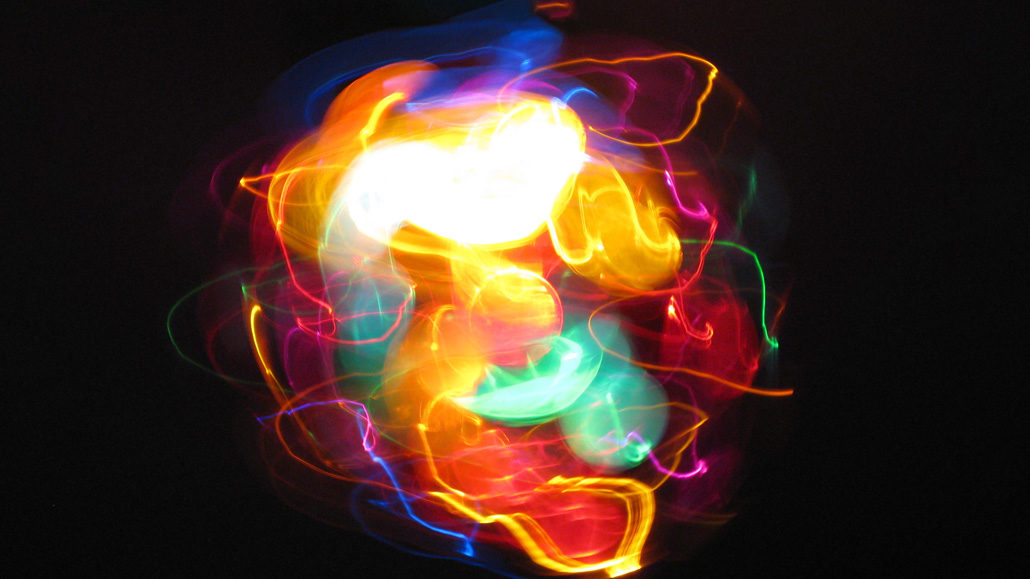
Light is a form of energy created by the movement of electrons. Different wavelengths appear as different colors, although most wavelengths are not visible to the human eye.
Natasha Hartano/Flickr ( CC BY-NC 2.0 ); adapted by L. Steenblik Hwang
Share this:
- Google Classroom
By Jennifer Look
July 16, 2020 at 6:30 am
Light is a form of energy that travels as waves. Their length — or wavelength — determines many of light’s properties. For instance, wavelength accounts for light’s color and how it will interact with matter. The range of wavelengths, from super short to very, very long, is known as the light spectrum. Whatever its wavelength, light will radiate out infinitely unless or until it is stopped. As such, light is known as radiation.
Light’s formal name is electromagnetic radiation. All light shares three properties. It can travel through a vacuum. It always moves at a constant speed, known as the speed of light, which is 300,000,000 meters (186,000 miles) per second in a vacuum. And the wavelength defines the type or color of light.
Just to make things interesting, light also can behave as photons , or particles. When looked at this way, quantities of light can be counted, like beads on a string.
Humans have evolved to sense a small part of the light spectrum. We know these wavelengths as “visible” light. Our eyes contain cells known as rods and cones. Pigments in those cells can interact with certain wavelengths (or photons) of light. When this happens, they create signals that travel to the brain. The brain interprets the signals from different wavelengths (or photons) as different colors.
The longest visible wavelengths are around 700 nanometers and appear red. The range of visible light ends around 400 nanometers. Those wavelengths appear violet. The whole rainbow of colors falls in between.

Most of the light spectrum, however, falls outside that range. Bees, dogs and even a few people can see ultraviolet (UV) light . These are wavelengths a bit shorter than violet ones. Even those of us without UV vision can still respond to UV light, however. Our skin will redden or even burn when it encounters too much.
Many things emit heat in the form of infrared light. As that name suggests, infrared wavelengths are somewhat longer than red’s. Mosquitoes and pythons can see in this range. Night-vision goggles work by detecting infrared light.
Light also comes in many other types. Light with really short, high-energy waves can be gamma rays and X-rays (used in medicine). Long, low-energy waves of light fall in the radio and microwave part of the spectrum.
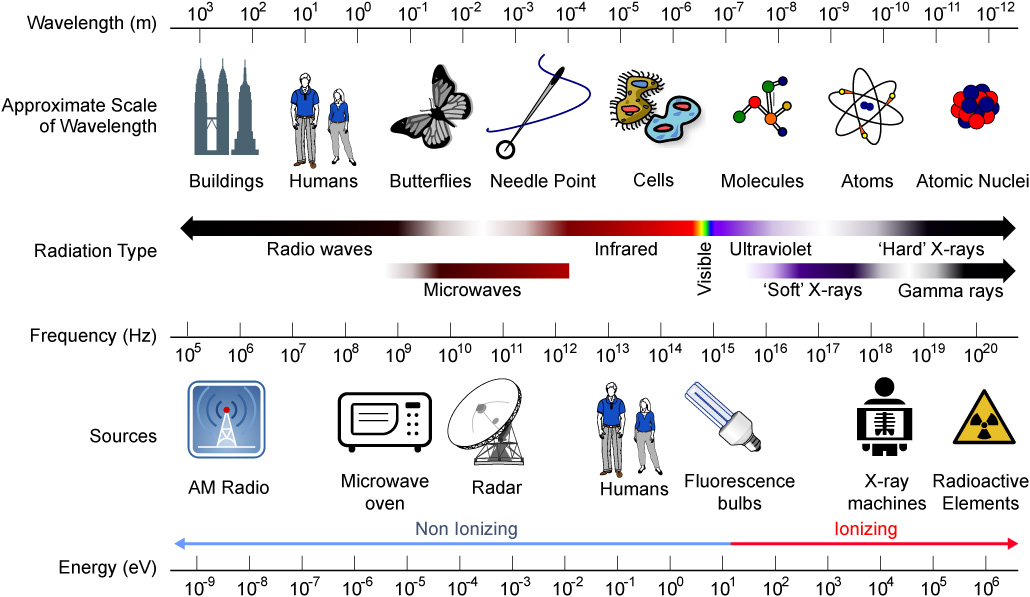
Desiré Whitmore is a physics educator at the Exploratorium in San Francisco, Calif. Teaching people about light as radiation can be difficult, she says. “People are afraid of the word ‘radiation.’ But all it means is that something is moving outward.”
The sun emits lots of radiation in wavelengths that span from X-rays to infrared. Sunlight provides almost all of the energy required for life on Earth. Small, cool objects release much less radiation. But every object emits some. That includes people. We give off small amounts of infrared light generally referred to as heat.
Whitmore points to her cell phone as a common source of many types of light. Smartphones use visible wavelengths to light up the screen display. Your phone talks to other phones via radio waves. And the camera has the ability to detect infrared light that human eyes cannot see. With the right app, the phone transforms this infrared light into visible light that we can see on the phone’s screen.
“This is fun to try out with your cell phone’s front-facing camera,” Whitmore says. Use a remote control for a television or other device. Its light is infrared, she notes, “so we cannot see it. But when you point the controller at your phone’s camera and press a button, “you can see a bright pink light appear on the screen!”
“All these different types of radiation help improve our lives,” Whitmore says. They “have been shown to be safe when used in reasonable amounts,” she notes — but can be “dangerous when you use too much of it.”
More Stories from Science News Explores on Physics

New lab trick makes diamonds without extreme pressure

Experiment: How to make the boldest, brightest tie-dye!

Flowers may electrically detect bees buzzing nearby

Here’s why scientists want a good quantum computer


Aerodynamics involved in shooting hoops can make vehicles greener

A bit of electricity can glue hard metals to soft materials

The movie Frozen inspired the icy, 3-D printing of blood vessels

Let’s learn about particles that help us peer inside objects

What Is a Light-Year?

An image of distant galaxies captured by the NASA/ESA Hubble Space Telescope. Credit: ESA/Hubble & NASA, RELICS; Acknowledgment: D. Coe et al.
For most space objects, we use light-years to describe their distance. A light-year is the distance light travels in one Earth year. One light-year is about 6 trillion miles (9 trillion km). That is a 6 with 12 zeros behind it!
Looking Back in Time
When we use powerful telescopes to look at distant objects in space, we are actually looking back in time. How can this be?
Light travels at a speed of 186,000 miles (or 300,000 km) per second. This seems really fast, but objects in space are so far away that it takes a lot of time for their light to reach us. The farther an object is, the farther in the past we see it.
Our Sun is the closest star to us. It is about 93 million miles away. So, the Sun's light takes about 8.3 minutes to reach us. This means that we always see the Sun as it was about 8.3 minutes ago.
The next closest star to us is about 4.3 light-years away. So, when we see this star today, we’re actually seeing it as it was 4.3 years ago. All of the other stars we can see with our eyes are farther, some even thousands of light-years away.
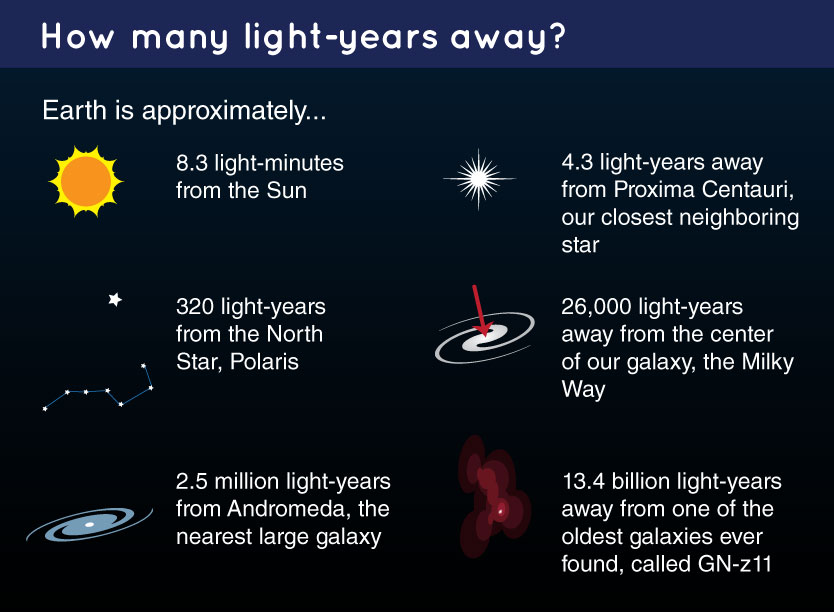
Stars are found in large groups called galaxies . A galaxy can have millions or billions of stars. The nearest large galaxy to us, Andromeda, is 2.5 million light-years away. So, we see Andromeda as it was 2.5 million years in the past. The universe is filled with billions of galaxies, all farther away than this. Some of these galaxies are much farther away.
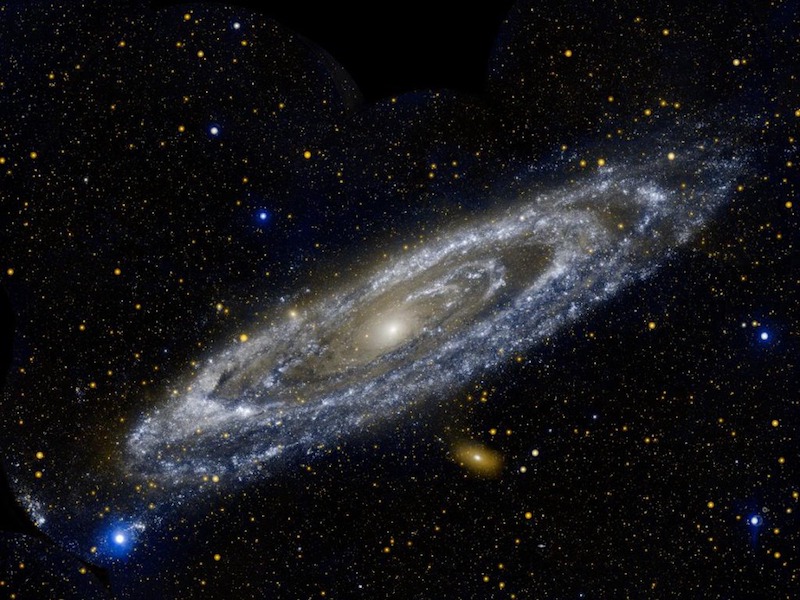
An image of the Andromeda galaxy, as seen by NASA's GALEX observatory. Credit: NASA/JPL-Caltech
In 2016, NASA's Hubble Space Telescope looked at the farthest galaxy ever seen, called GN-z11. It is 13.4 billion light-years away, so today we can see it as it was 13.4 billion years ago. That is only 400 million years after the big bang . It is one of the first galaxies ever formed in the universe.
Learning about the very first galaxies that formed after the big bang, like this one, helps us understand what the early universe was like.
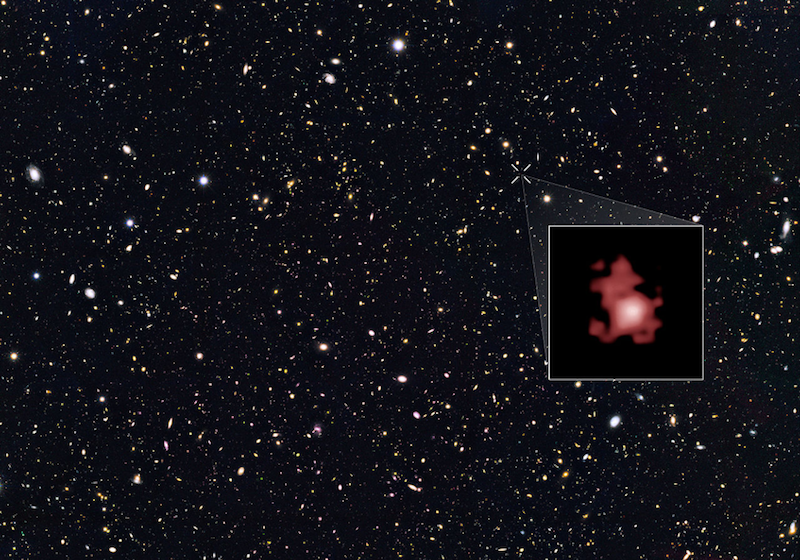
This picture shows hundreds of very old and distant galaxies. The oldest one found so far in GN-z11 (shown in the close up image). The image is a bit blurry because this galaxy is so far away. Credit: NASA, ESA, P. Oesch (Yale University), G. Brammer (STScI), P. van Dokkum (Yale University), and G. Illingworth (University of California, Santa Cruz)
More to explore

What Is a Galaxy?
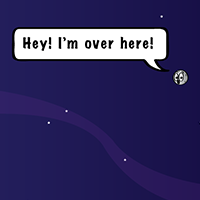
How Far Away Is the Moon?
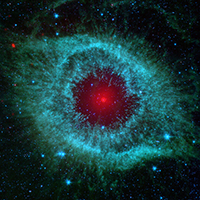
What Is a Nebula?
If you liked this, you may like:
How far does light travel in the ocean?
Light may be detected as far as 1,000 meters down in the ocean , but there is rarely any significant light beyond 200 meters..
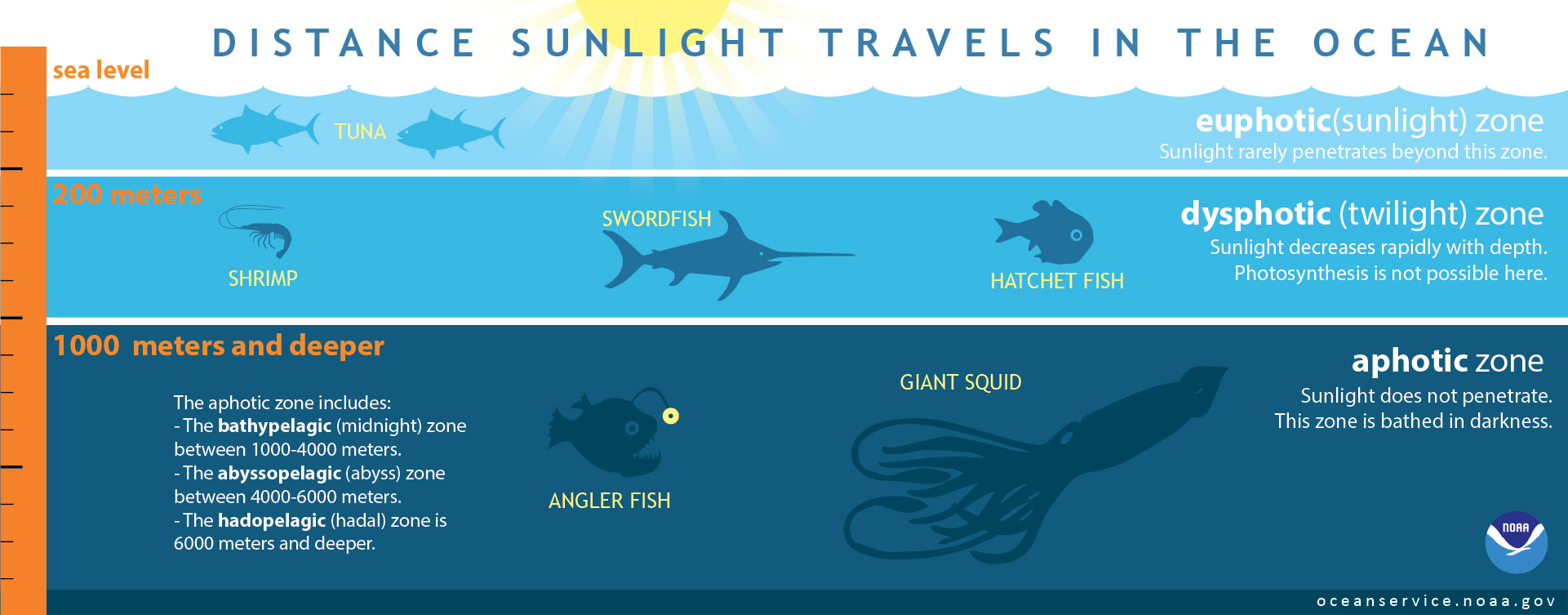
The ocean is divided into three zones based on depth and light level. Although some sea creatures depend on light to live, others can do without it. ‘Photic’ is a derivative of ‘photon,’ the word for a particle of light. A full transcript is available that presents this infographic content in plain text.
Sunlight entering the water may travel about 1,000 meters into the ocean under the right conditions, but there is rarely any significant light beyond 200 meters .
The ocean is divided into three zones based on depth and light level. The upper 200 meters of the ocean is called the euphotic , or " sunlight ," zone. This zone contains the vast majority of commercial fisheries and is home to many protected marine mammals and sea turtles.
Only a small amount of light penetrates beyond this depth.
The zone between 200 meters and 1,000 meters is usually referred to as the “ twilight ” zone, but is officially the dysphotic zone. In this zone, the intensity of light rapidly dissipates as depth increases. Such a minuscule amount of light penetrates beyond a depth of 200 meters that photosynthesis is no longer possible.
The aphotic zone exists in depths below 1,000 meters . Sunlight does not penetrate to these depths and the zone is bathed in darkness. The aphotic zone is further subdivided into the bathypelagic zone (or midnight zone) between 1,000 and 4,000 meters, the abyssopelagic (or the abyss ) between 4,000 and 6,000 meters , and the hadopelagic zone (or hadal zone) 6,000 meters and deeper.
Infographic Transcript: Distance Sunlight Travels in the Ocean
- The left side of this graphic shows a measuring stick against a representation of the ocean; it shows three depths: sea level, 200 meters, and 1,000 meters and deeper.
- The middle portion of the graphic shows the ocean divided into three zones. The first division from sea level to 200 meters is labeled as the euphotic (sunlight) zone and says "sunlight rarely penetrates beyond this zone." Graphic representations of tuna are shown swimming in this first zone. The second division from 200 meters to 1,000 meters is labeled as the dysphotic (twilight) zone and says "sunlight decreases rapidly with depth; photosynthesis is not possible here." Graphic representations of shrimp, swordfish, and hatchet fish are shown swimming in this second zone. The third division is labeled from 1,000 meters and deeper and is labeled as the aphotic zone and says "sunlight does not penetrate; the zone is bathed in darkness." Graphic representations of angler fish and giant squid are shown swimming in this zone.
- The division labeled 'aphotic zone' contains this additional text: "The aphotic zone incudes: The bathypelagic (midnight) zone between 1,000-4,000 meters; the abyssopelagic (abyss) zone between 4,000-6,000 meters; and the hadopelagic (hadal) zone is 6,000 meters and deeper.
- A solid blue thin line is at the bottom of the graphic shows the website address of the National Ocean Service and the NOAA logo.
More Information
How far does light travel in the ocean? (Ocean Explorer)
Search Our facts
Last updated:
Author: NOAA
How to cite this article
- ABBREVIATIONS
- BIOGRAPHIES
- CALCULATORS
- CONVERSIONS
- DEFINITIONS

Vocabulary
What does light travel mean?
Definitions for light travel light trav·el, this dictionary definitions page includes all the possible meanings, example usage and translations of the word light travel ., did you actually mean lister plow , how to pronounce light travel.
Alex US English David US English Mark US English Daniel British Libby British Mia British Karen Australian Hayley Australian Natasha Australian Veena Indian Priya Indian Neerja Indian Zira US English Oliver British Wendy British Fred US English Tessa South African
How to say light travel in sign language?
Chaldean Numerology
The numerical value of light travel in Chaldean Numerology is: 1
Pythagorean Numerology
The numerical value of light travel in Pythagorean Numerology is: 8
Word of the Day
Would you like us to send you a free new word definition delivered to your inbox daily.
Please enter your email address:
Citation
Use the citation below to add this definition to your bibliography:.
Style: MLA Chicago APA
"light travel." Definitions.net. STANDS4 LLC, 2024. Web. 26 Jun 2024. < https://www.definitions.net/definition/light+travel >.
Discuss these light travel definitions with the community:
Report Comment
We're doing our best to make sure our content is useful, accurate and safe. If by any chance you spot an inappropriate comment while navigating through our website please use this form to let us know, and we'll take care of it shortly.
You need to be logged in to favorite .
Create a new account.
Your name: * Required
Your email address: * Required
Pick a user name: * Required
Username: * Required
Password: * Required
Forgot your password? Retrieve it
Are we missing a good definition for light travel ? Don't keep it to yourself...
Image credit, the web's largest resource for, definitions & translations, a member of the stands4 network, free, no signup required :, add to chrome, add to firefox, browse definitions.net, are you a words master, either of two different animal or plant species living in close association but not interdependent, Nearby & related entries:.
- light the universe
- light therapy
- light time noun
- light touch noun
- light travel
- light troops
- light truck
- light unit noun
- light up verb
Alternative searches for light travel :
- Search for light travel on Amazon

- Share full article
Advertisement
Supported by
Today Is the Longest Day of the Year in the Northern Hemisphere
We have Earth’s off-kilter tilt to thank for the summer solstice, as well as the different seasons.

By Katrina Miller
On Thursday, everyone in the northern half of our planet will experience the summer solstice. It’ll be the longest day of the year north of the Equator, and it is the scientific start of summer.
Earth has a solstice every six months, in June and in December. Leading up to the summer solstice, the sun appears in a higher spot in the sky at the same time each day until it reaches its maximum point.
After the summer solstice, the days will get shorter. The sun will appear lower in the sky each day until the winter solstice, on Dec. 21.
What time is the summer solstice this year?
According to the National Weather Service , the summer solstice will occur on Thursday at 4:51 p.m. Eastern time. This is the moment during the day when the sun reaches its most northern point in the sky during the year.
Why do we have solstices?
The sun’s height in the sky each day changes because Earth spins on an axis that is tilted 23.5 degrees away from vertical. This means that depending on the time of year the hemispheres lean either toward or away from the sun.
This is what gives Earth its seasons: When the northern half of the planet leans toward the sun, it experiences summer; at the same time, the southern half of the planet leans away from the sun, and is in winter. It is a mystery why Earth is angled this way, though some astronomers believe that its tilt paved the way for life to exist .
In the Northern Hemisphere, the summer solstice happens when Earth’s tilt toward the sun is greatest. Despite this, the hottest temperatures of the year usually occur a few weeks later , in July or August, because it takes time for the sun’s rays to warm our planet.
Do other planets in our solar system have solstices?
Any planet that is tilted will have solstices. According to NASA , every planet in our solar system has an axial tilt, but some are more pronounced than others.
Venus and Jupiter have only slight leans, around 3 degrees, while Mercury, at 0.03 degrees, is barely slanted at all. On the other hand, Uranus is oriented a whopping 97.8 degrees from vertical, causing one of its poles to point directly at the sun at times. That extreme tilt causes it to have some of the most dramatic seasons in our solar system.
Saturn and Neptune both have tilts close to Earth’s. So does Mars, at 25.2 degrees, although the red planet’s tilt has shifted dramatically over millions of years .
How do people celebrate the summer solstice?
Every year, people around the world ring in the June solstice with midsummer bonfires, festivals and — for those living above the Arctic Circle — midnight sun celebrations . At the other end of the world, scientists living in Antarctica throw their annual midwinter feast to commemorate the longest, darkest night on the continent.
Others travel to ancient ruins, like Stonehenge in England or the Temple of the Sun in Peru, to greet the solstice sun the way ancient peoples once did.
Katrina Miller is a science reporter for The Times based in Chicago. She earned a Ph.D. in physics from the University of Chicago. More about Katrina Miller
What’s Up in Space and Astronomy
Keep track of things going on in our solar system and all around the universe..
Never miss an eclipse, a meteor shower, a rocket launch or any other 2024 event that’s out of this world with our space and astronomy calendar .
The company SpaceX achieved a key set of ambitious goals on the fourth test flight of a vehicle that is central to Elon Musk’s vision of sending people to Mars.
Euclid, a European Space Agency telescope launched into space last summer, finally showed off what it’s capable of with a batch of breathtaking images and early science results.
A dramatic blast from the sun set off the highest-level geomagnetic storm in Earth’s atmosphere, making the northern lights visible around the world .
With the help of Google Cloud, scientists who hunt killer asteroids churned through hundreds of thousands of images of the night sky to reveal 27,500 overlooked space rocks in the solar system .
Is Pluto a planet? And what is a planet, anyway? Test your knowledge here .
Aer Lingus pilots launch work-to-rule actions, putting passengers into disarray
Aer Lingus pilots have launched an industrial action, leading to the cancellation of hundreds of flights and tossing the travel plans of tens of thousands into disarray
LONDON -- Aer Lingus pilots launched an industrial action on Wednesday, leading to the cancellation of hundreds of flights and tossing the travel plans of tens of thousands into disarray.
Pilots imposed ‘’work to rule’’ actions, refusing to work overtime, accept changes in set rosters or take out-of-hours management requests. An eight-hour strike is planned on Saturday.
The flag carrier of Ireland and its pilots have been locked in a bitter dispute over pay, with pilots seeking a pay increase of 24% to keep pace with inflation since their last pay raise in 2019. Aer Lingus has said it is willing to offer pay increases of 12.5% or more if “productivity and flexibility” are discussed.
Ireland's prime minister, Simon Harris, said it is “absolutely vital” that a resolution is found.
“My challenge to the parties now is to bring that engagement forward, rather than putting people through a prolonged period of agony and chaos, and then engaging in the end anyway,” Harris said Tuesday. “This dispute will be settled the same way every dispute is settled: compromise, engagement, sitting around a table. That’s what needs to happen.”
Related Topics
Trending reader picks.

Notes shed light on Trump's efforts to hide docs
- Jun 25, 6:00 PM

Man dies after being struck by roller coaster
- Jun 24, 12:52 PM

Body found in search for missing hiker
- Jun 24, 2:42 PM
Woman drowns at national park
- Jun 25, 6:11 PM

Parents at beach with kids die in rip current
- Jun 21, 8:38 AM
ABC News Live
24/7 coverage of breaking news and live events

Solar eclipse 2024: A traveller’s guide to the best places to be when the light goes out
O n 8 April 2024, a total solar eclipse will sweep across North America , providing an astronomical experience in many alluring locations.
Only a tiny proportion of humanity has ever witnessed a total eclipse – but tens of millions of people will be able to experience one as the “path of totality” sweeps from the Pacific to the Atlantic during the course of that magical Monday.
Here’s what you need to know about why you should see it and where to be.
What happens during a total solar eclipse?
The greatest show on earth comes courtesy of the lifeless moon. Normally the orbiting lunar lump merely provides earth with tides, moonlight and somewhere to aim space rockets. But roughly once a year the natural satellite aligns with the sun and, thanks to a geometric miracle, blots out the hub of the solar system to create a total eclipse.
“Even though the moon is 400 times smaller than the sun, it’s also about 400 times closer to earth than the sun is,” says Nasa. “This means that from earth, the moon and the sun appear to be roughly the same size in the sky.”
A narrow band marking the “path of totality” carves an arc of darkness across the surface of our planet. If you are somewhere on that line at the predicted time, and you have clear skies, then the experience will become a lifelong memory.
The closer you are to the centre of the path of totality, the longer the total eclipse will last. The astronomer Dr John Mason, who has guided dozens of eclipse trips (and will be doing so again in 2024), says: “People down in southwest Texas will get about four minutes 20 seconds, and that reduces to about three minutes 20 seconds up in the northeast. That’s a pretty good, long total eclipse.”
What’s so good about seeing an eclipse?
In the days leading up to the eclipse, locations in the path of totality acquire something of a carnival atmosphere as astronomical tourists converge in excited anticipation.
On the day, the cosmological performance begins with a warm-up lasting more than an hour, during which the moon steadily nibbles away at the surface of the sun.
Suddenly, you experience totality. The stars and planets appear in the middle of the day. The air chills.
To testify to the heavenly fit between our two most familiar heavenly bodies, faint diamonds known as Baily’s beads peek out from behind the moon. They actually comprise light from the sun slipping through lunar valleys.
A sight to behold – so long as you can see the moon blotting out the sun and appreciate the mathematical perfection of nature in our corner of the galaxy.
Eclipses are entirely predictable: we know the stripes that the next few dozen will paint upon the surface of the Earth. But the weather is not. Cloud cover, which blighted the Cornwall eclipse in 1999, downgrades a cosmological marvel to an eerie daytime gloom.
Almost as predictable as the eclipse is that traffic towards the path of totality will be heavy on the morning of 8 April 2024.
Accommodation rates are astronomical: even humdrum motel rooms in Niagara, central in the path of totality, are selling for C$600 (£350) for the night of 7-8 April 2024.
Where will the great American eclipse 2024 be visible?
The path of totality makes landfall from the Pacific at Mazatlan on Mexico’s Pacific Coast and sweeps northeastwards to reach the US-Mexican border at Piedras Negras.
In the US, three big Texan cities – San Antonio, Austin and Dallas – are on the extremes of the path of totality; many citizens are likely to drive to locations near the centre of the line.
Arkansas will be an attractive place to see the eclipse , with both Texarkana (on the border with Texas) and Little Rock within the path of totality.
In the Midwest, Indianapolis and Cleveland share the distinction of being fairly central in the path of totality. In upstate New York, Buffalo and nearby Niagara Falls (shared with Canada) could be extremely attractive – though prone in early April to cloudy skies.
In Canada , Montreal is just touched by the path of totality. The line then reverts to the US, passing across northern Maine – which promises to be a superb with clear skies. Then back to Canada’s Maritime Provinces, with New Brunswick, Prince Edward Island and Newfoundland all in the line of darkness.
Will I be able to see a partial eclipse from the UK?
Yes. The eclipse ends with the sunset in the eastern Atlantic, about 600 miles off the coast of Cornwall , before it reaches the UK and Ireland . But on the island of Ireland and western parts of Great Britain, a partial eclipse may be visible with the sun low in the sky.
If skies are clear and you have an open view to the west, it will start at around 7.55pm in Cardiff, Liverpool , Manchester, Edinburgh and Glasgow.
BBC Weather presenter Simon King said: “With the partial solar eclipse occurring late in the day UK time, the Sun will be low to the horizon and will actually set before the spectacle is over.”
Can I combine an exciting city with a partial eclipse?
Boston, New York and Chicago are among the big cities that will see a sizeable chunk of the sun blotted out. Viewer as far apart as Alaska and the far north of Colombia and the Caribbean will, if skies are clear and they use the correct eye protection, see a partial eclipse. But there is nothing to compare with a total eclipse.
Eclipse guru Dr Mason sums up the difference between a 99 per cent partial eclipse and a total eclipse as far apart as “a peck on the cheek and a night of passion”.
“There will be people who will look at the map and say, ‘I live in Cincinnati or I live in Columbus [Ohio] and I’m just outside the zone of totality. But I’m going to get a 99 per cent-plus eclipse, so maybe I won’t bother to travel’.
“What they don’t realise is there an enormous difference between 99 per cent and 100 per cent. And there’s a range of phenomena that they won’t see if they put up with 99 per cent.”
You must use special eclipse safety glasses or viewers when viewing a partial eclipse or during the partial phases of a total solar eclipse.
Where should I be for the total experience?
There are no guarantees of clear skies: all you can do is play the odds based on the record of cloud cover for the corresponding date in previous years.
Dr Mason says the average expected cloud cover amounts increase from around 40-45 per cent on the Mexico/Texas border to over 80 per cent in Maine, New Brunswick and Newfoundland.
Three particularly tempting locations:
- Southern Texas , close to San Antonio or Austin. Besides clear skies being more likely than not, access is easy with direct flights to Austin. Importantly there is much to explore in the region before and after the eclipse, from Big Bend National Park on the Rio Grande to Space Center Houston – an excellent place to continue the cosmological theme.
- Northern Arkansas , a picturesque part of the state, with the added attraction of Memphis just a couple of hours away.
- Niagara Falls : the dramatic border between the US and Canada could be an eclipse washout due to clouds. But the natural surroundings are impeccable – and there is plenty of accommodation, which will avoid the risk of being caught in severe traffic congestion on the freeways from Toronto and locations in New York State.
However, the most recent forecasts for cloud cover suggest that the Midwest around Indianapolis and the northeastern state of Maine could have the best prospects.
When are the next total solar eclipses?
Summer 2026 – Wednesday 12 August, to be precise – should bring a spectacular eclipse visible in northern Spain at the height of the European holiday season. The path of totality begins in the Arctic and crosses Greenland and Iceland before arriving in the northern half of Spain. The stripe of darkness will traverse the great cities of Bilbao, Zaragoza and Valencia in mainland Spain before arriving in Palma de Mallorca.
The following summer (2 August 2027), the southern tip of mainland Spain is in the path of totality for an eclipse that will sweep across North Africa and the Arabian peninsula : going east from the Strait of Gibraltar, it will encompass Morocco, Algeria, Tunisia, Libya, Egypt, the northeasternmost corner of Sudan, Saudi Arabia and Yemen.
Just under 12 months later, on 22 July 2028, Outback Australia will be the place to be. A total eclipse will make landfall in northern Western Australia, sweep across the Northern Territory and part of southwest Queensland – then clean across New South Wales, with Sydney in the middle of the path of totality.
Winter cloud cover could disrupt the experience in Australia’s largest city – and is very likely in the southern portion of New Zealand’s South Island where the eclipse reaches a finale.
Australia also features in the cosmological plans on 25 November 2030. This is early summer in the southern hemisphere, and likely to be good conditions for viewing in Namibia, Botswana and South Africa (Durban is on the path of totality) as well as South Australia.
The Independent is the world’s most free-thinking news brand, providing global news, commentary and analysis for the independently-minded. We have grown a huge, global readership of independently minded individuals, who value our trusted voice and commitment to positive change. Our mission, making change happen, has never been as important as it is today.
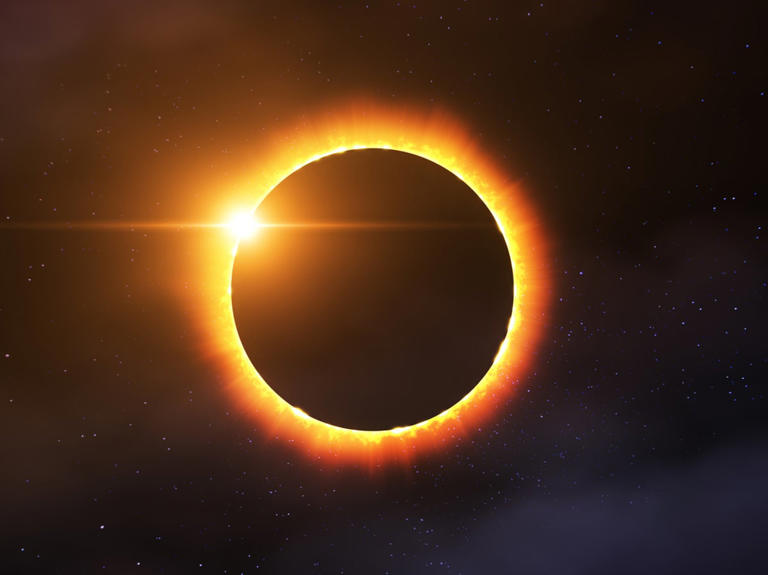
- Central Oregon
- Decision 2024
- Oregon-Northwest
- Crime Stoppers
- KTVZ.COM Polls
- Special Reports
- Ask the Mayor
- Interactive Radar
- Local Forecast
- Road Conditions – Weather Webcams
- Prep Scoreboard
- Livestream Newscasts
- Livestream Special Coverage
- Local Videos
- Photo Galleries
- 21 Cares For Kids
- Community Billboard
- Community Conversations
- Community Links
- One Class At a Time
- Pay it Forward
- House & Home
- Entertainment
- Events Calendar
- Pump Patrol
- Father’s Day Giveaway 2024
- Central Oregon Backyard Living Photo Contest 2024
- Junior Forecaster
- Pet Pics Sweepstakes
- Sunrise Birthdays
- Submit Tips, Pics and Video
- KTVZ Careers
- Central Oregon Careers
- Email Newsletters
- Advertise with NPG of Oregon
- Careers and Internships
- Closed Captioning
- Download Our Apps
- EEO Public Filing
- FCC Public File
- NewsChannel 21 Team
- On-Air Status
- Receiving KTVZ
- TV Listings
LGBTQ+ travel website provides community, safety for gay tourists

By Juliette Goodrich
Click here for updates on this story
SAN FRANCISCO ( KPIX ) — A tech start up is trying to help make travel safer for the LGBTQ+ community with a platform described as the world’s largest short-term vacation rental marketplace for gay travelers.
The site is called MisterBandB.com . It features one million hosts in countries worldwide, all confirmed to be LGBTQ+ friendly.
One host in San Francisco told CBS News Bay Area he loves providing a safe travel space for LGBTQ+ vacationers.
Joaquin Aran has lived in his San Francisco home for three years.
“I love my neighbors. I love my neighborhood,” said Arana.
His love of traveling safely as a gay man and his love of the Bay Area is why he wanted to be a host on the website. More than one million LGBTQ+ travelers can not only find housing on the site, but also connect with locals to get safety tips and plan trips and activities.
Mattieu Jost, the creator of Mister B&B, came up with the idea after experiencing homophobic harassment when he booked a room at a home in Spain with his partner.
“She really reacted badly and so we decided to leave. And on the way back to the airport, this is how I created Mr. B and B,” said founder Jost. The global traveler and entrepreneur is now living in Paris, France.
The website is getting support from investors and hosts like Arana, who also uses the site to travel himself.
“We have traveled to Norway, the Philippines, Taiwan, Portugal and India,” said Arana.
He admitted traveling can be risky in some states and countries if you are gay.
“There are places where the politics and people are not necessarily aligned. There are people who are welcoming LGBTQ communities,” explained Arana.
He says it’s about finding community in other parts of the world.
“In those places, our people need to be supported. They need to be seen and they also need to see that they need to see us. The world needs to see us that we have families and jobs and are home,” said Arana.
He regularly cooks for the travelers he hosts and makes sure his home is a welcome all year long.
“I like having a flag out. It is home and it’s part of who I am. It is a large part and important to understand,” said Arana.
Please note: This content carries a strict local market embargo. If you share the same market as the contributor of this article, you may not use it on any platform.
Jump to comments ↓
CNN Newsource
Related articles.

Logging accident severely injures Oregon man
Man shot after alleged altercation in parking lot outside bar early monday morning.

Bus driver in critical condition after stabbing; EMBARK says safety measure are in place
2 dead after being swept down north fork american river, officials say.
KTVZ NewsChannel 21 is committed to providing a forum for civil and constructive conversation.
Please keep your comments respectful and relevant. You can review our Community Guidelines by clicking here
If you would like to share a story idea, please submit it here .

IMAGES
VIDEO
COMMENTS
A Ray of Light. When an electromagnetic source generates light, the light travels outward as a series of concentric spheres spaced in accordance with the vibration of the source. Light always takes the shortest path between a source and destination. A line drawn from the source to the destination, perpendicular to the wave-fronts, is called a ray.
On one hand, the speed of light is just a number: 299,792,458 meters per second. And on the other, it's one of the most important constants that appears in nature and defines the relationship of ...
Light actually "slows down" every time it has to travel through anything but a vacuum. Look up Cherenkov radiation to see what happens when light initially travels faster than it can through a ...
The speed of light in a vacuum is 186,282 miles per second (299,792 kilometers per second), and in theory nothing can travel faster than light.
The speed of light in vacuum, commonly denoted c, is a universal physical constant that is exactly equal to 299,792,458 metres per second (approximately 300,000 kilometres per second; 186,000 miles per second; 671 million miles per hour). According to the special theory of relativity, c is the upper limit for the speed at which conventional matter or energy (and thus any signal carrying ...
Speed of light, speed at which light waves propagate through different materials. In a vacuum, the speed of light is 299,792,458 meters per second. The speed of light is considered a fundamental constant of nature. Its significance is far broader than its role in describing a property of electromagnetic waves.
Ergo, light is made of electromagnetic waves and it travels at that speed, because that is exactly how quickly waves of electricity and magnetism travel through space. And this was all well and ...
Basically, traveling at incredible speeds (299 792 458 m/s) and at different wavelengths, depending on its energy. It also behaves as both a wave and a particle, able to propagate through mediums ...
Light travels much faster than sound. Light travels at a speed of 299,792,458 m/s (that's nearly 300,000 km/s!). The distance around the Earth is 40,000 km, so in 1 second, light could travel seven and a half times around the world. Sound only travels at about 330 m/s through the air, so light is nearly a million times faster than sound.
Electromagnetic radiation is one of the many ways that energy travels through space. The heat from a burning fire, the light from the sun, the X-rays used by your doctor, as well as the energy used to cook food in a microwave are all forms of electromagnetic radiation. While these forms of energy might seem quite different from one another ...
So how does light travel? Basically, traveling at incredible speeds (299 792 458 m/s) and at different wavelengths, depending on its energy. It also behaves as both a wave and a particle, able to ...
Light is a primary tool for perceiving the world and interacting with it for many organisms. Light from the Sun warms the Earth, drives global weather patterns, and initiates the life-sustaining process of photosynthesis; about 10 22 joules of solar radiant energy reach Earth each day. Light's interactions with matter have also helped shape the structure of the universe.
introduction. Light is a transverse, electromagnetic wave that can be seen by the typical human. The wave nature of light was first illustrated through experiments on diffraction and interference. Like all electromagnetic waves, light can travel through a vacuum. The transverse nature of light can be demonstrated through polarization.
Nowadays, the speed of light is used to define units of length, so its value is fixed; humans have essentially agreed the speed of light is 299,792.458 kilometers per second, exactly. Light doesn ...
Light is a type of electromagnetic radiation that can be detected by the eye. It travels as a transverse wave. Unlike a sound waves, light waves do not need a medium to pass through, they can ...
Here's an example: We've always taken for granted that light travels faster than anything else in the universe. Then, in 1999, researchers at Harvard University were able to slow a beam of light down to 38 miles an hour (61 kilometers per hour) by passing it through a state of matter known as a Bose-Einstein condensate.
All light shares three properties. It can travel through a vacuum. It always moves at a constant speed, known as the speed of light, which is 300,000,000 meters (186,000 miles) per second in a vacuum. And the wavelength defines the type or color of light. Just to make things interesting, light also can behave as photons, or particles. When ...
The distance light would travel (from the open notch to the mirror and back to the point where a tooth could eclipse the light) was measured. Fizeau timed the eclipses and observed the rotational speed of the disk at the time of the eclipses. With this information he calculated that the speed of light in air was 194,000 miles per second.
How does light travel? Light travels in waves and in today's science video for kids, you will learn about how light rays move and are reflected, absorbed an...
Light travels at a speed of 186,000 miles (or 300,000 km) per second. This seems really fast, but objects in space are so far away that it takes a lot of time for their light to reach us. The farther an object is, the farther in the past we see it. Our Sun is the closest star to us. It is about 93 million miles away.
Light may be detected as far as 1,000 meters down in the ocean, but there is rarely any significant light beyond 200 meters. The ocean is divided into three zones based on depth and light level. Although some sea creatures depend on light to live, others can do without it. 'Photic' is a derivative of 'photon,' the word for a particle of ...
Faster-than-light ( superluminal or supercausal) travel and communication are the conjectural propagation of matter or information faster than the speed of light ( c ). The special theory of relativity implies that only particles with zero rest mass (i.e., photons) may travel at the speed of light, and that nothing may travel faster.
Blue light, as a shorter wavelength of light, scatters more than longer wavelengths of light, such as red light. During sunsets, light must travel through more of Earth's atmosphere, causing blue light to scatter further, essentially making it invisible to the human eye. It is then possible to view lower-energy light, such as red and orange ...
Definition of light travel in the Definitions.net dictionary. Meaning of light travel. Information and translations of light travel in the most comprehensive dictionary definitions resource on the web.
Others travel to ancient ruins, like Stonehenge in England or the Temple of the Sun in Peru, to greet the solstice sun the way ancient peoples once did. Katrina Miller is a science reporter for ...
Travel Tour an 18th century pig barn turned art studio and summer home on Nantucket Greater Light is the vision of two artistic sisters nearly a century ago.
In most of the world, the magic of the night sky has slowly been lost to the modern realities of light pollution. But in Flagstaff, Arizona - the world's first international Dark Sky City ...
LONDON -- Aer Lingus pilots launched an industrial action on Wednesday, leading to the cancellation of hundreds of flights and tossing the travel plans of tens of thousands into disarray. Pilots ...
Solar eclipse 2024: A traveller's guide to the best places to be when the light goes out - A narrow band marking the path of totality carves an arc of darkness across the surface of our planet
KPIX via CNN Newsource A tech start up is trying to help make travel safer for the LGBTQ+ community with a platform described as the world's largest short-term vacation rental marketplace for gay ...